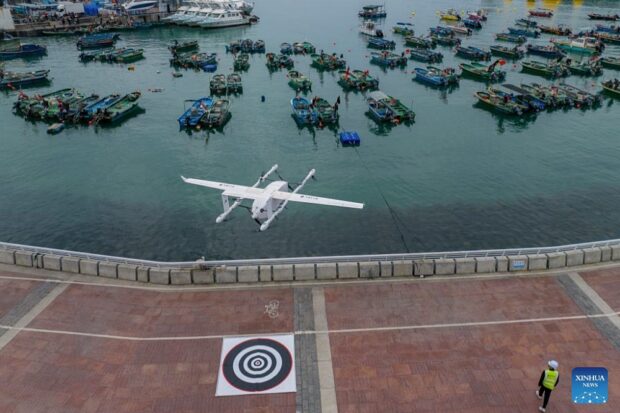A drone delivery route flying seafood from Nan’ao Shuangyong Pier in the east of Shenzhen to the city’s Longgang District in south China began last week.
The drones take off with up to a 20 kilogram load of seafood which is then delivered to local couriers who sell it on to customers. Products delivered include freshly-caught crabs, lobster, all types of fish, prawns, crayfish, clams, oysters and mussels. Seafood store workers place the items in a strong red bag and then load it on to a drone that operates for the courier SF Express .
A subsidiary, SF UAS, became the first in China to obtain a license for trialling delivery drones back in January 2022. By September of that year, the company had established 66 different routes covering areas in Longgang, Nanshan, Luohu, Longhua and Pingshan.
The following year, the company began testing commercial operations over long distances in Yulin city and other areas situated in the country’s northwest. The pilot area was then expanded to a wider region of China with the aim of building an air transport network with SF Express consisting of large manned cargo planes, Unmanned Aerial Vehicles and end-delivery drones.
These successful trials have now led to the seafood operation in Shenzhen, a city well-versed and used to drone transportation.
For another company, delivery giant Meituan, has been employing these craft extensively, flying food and general products between skyscrapers to special kiosks around the city since 2022. The company made more than 100,000 deliveries that year alone. Today, for many Shenzhen residents and vendors, delivery by drone is no longer a novelty, but part of a daily routine.
Meituan launches its drones from five delivery hubs, including a rooftop on a large shopping mall. Usually, ten or more craft are located there with two or three either taking off or landing at the same time.
The workflow is a mix of human and automated labour. Once the company gains an order (customers order specific items from an app), a runner (human) goes to the restaurants, located in the shopping mall, to pick up the food and brings it to the launchpad. The runner then places the items in a standardised cardboard box, weighs it to make sure it’s not too heavy, seals the box, and hands it on to a different worker who places this under a drone and waits for it to lock in.
Mao Yinian, the Director of drone delivery services at Meituan, explained to MIT Technology Review,
“Everything after that is highly automated. The drones’ movements are controlled by a central algorithm where the routes are predetermined. You can know in advance, at every precise second, where each drone will be and how fast its speed is, so the customers can expect the arrival time with a deviation of two seconds, instead of three minutes or even ten minutes from traditional delivery.”
The company has a centralised control room in Shenzhen, where staff can take control of a craft in an emergency. There are now more than a hundred drones that can be deployed for deliveries in the city. On average, one operator is watching ten at the same time.
While in the West, drone delivery of food, drink and healthcare products is led by companies like Wing, Zipline, Matternet, Flytrex and Wingcopter, China is ahead of this competition, where the city of Shenzhen is a major tour de force.
Source: eVTOL Insights.com




